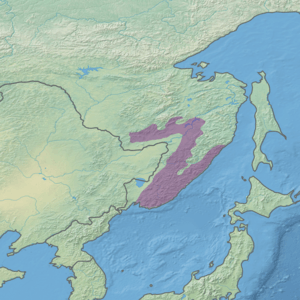Ussuri broadleaf and mixed forests
The Ussuri broadleaf and mixed forests ecoregion (WWF ID:PA0443) covers a mountainous areas above the lower Amur River and Ussuri River in Primorsky Krai and Khabarovsk Krai in the Russian Far East. The ecoregion is in the Palearctic realm, with a Humid Continental climate. It covers 187,357 km2 (72,339 sq mi).[1]
| Ecoregion: Ussuri broadleaf and mixed forests | |
|---|---|
.jpg) Bikin River Valley, Primorsky Krai | |
 Ecoregion territory (in purple) | |
| Ecology | |
| Realm | Palearctic |
| Biome | temperate broadleaf and mixed forests |
| Geography | |
| Area | 223,516 km2 (86,300 sq mi) |
| Countries | Russia |
Location and description
The ecoregion covers a "Z" shaped area in which the northern section is a 400 km band of forest north of Khabarovsk parallel to the Amur River (which is 20-30 km to the south), the vertical band of which parallels the Ussuri River (which is 20-30 km to the west) on the western slopes of the Sikhote-Alin Mountains, and the base of which is the eastern slope of the Sikhote-Alin in Primorsky Krai.[1][2]
Climate
The region has a Humid continental, cool summer climate (Koppen classification (Dwb)). This climate is characterized by high variation in temperature, both daily and seasonally; with dry winters and cool summers.[3]
| Climate at 46.75 N, 135.25 E | ||||||||||||||||||||||||||||||||||||||||||||||||||||||||||||
|---|---|---|---|---|---|---|---|---|---|---|---|---|---|---|---|---|---|---|---|---|---|---|---|---|---|---|---|---|---|---|---|---|---|---|---|---|---|---|---|---|---|---|---|---|---|---|---|---|---|---|---|---|---|---|---|---|---|---|---|---|
| Climate chart (explanation) | ||||||||||||||||||||||||||||||||||||||||||||||||||||||||||||
| ||||||||||||||||||||||||||||||||||||||||||||||||||||||||||||
| ||||||||||||||||||||||||||||||||||||||||||||||||||||||||||||
Flora and fauna
The Ussuri forests are the most biologically diverse in northern Asia.[2] The maritime influence moderates the climate, precipitation is high enough to support rich forests, and the region is a boundary area between mountains, river flat lands, and sea coast.[5][6]
The forests of the region are dominated by Spruce (Picea ajanensis), Dahurian larch (Larix gmelinii), Korean pine (Pinus koraiensis), Mongolian oak (Quercus mongolica), and Japanese white birch (Betula platyphylla).[6]
Protections
Notable protected areas of the Russian Federation in the ecoregion include:
- Bastak Nature Reserve, on the south-eastern spurs of the Bureya Massif]. (914 km2)
- Bolon Nature Reserve covering wetlands of the western approaches to Lake Bolon in the lower Amur River regions. (1,000 km2)
- Botcha Nature Reserve on the northeastern slopes of the Sikhote-Alin mountains. (2,674 km2)
- Komsomolsk Nature Reserve located where the Amur River cuts a narrow passage through the Sikhote-Alin. (643 km2)
- Khingan Nature Reserve includes forested spurs of the Lesser Khingan mountains. (940 km2)
- Sikhote-Alin Nature Reserve An IUCN class Ia "strict ecological reserve" (a Zapovednik). (4,016 km2)
- Ussurisky Nature Reserve, one of the remaining virgin mixed deciduous-conifer forests in the Primorsky (Maritime) region of the Russian Far East. Located on the western slopes of the Sikhote-Alin mountains. (404 km2)
These are all IUCN class Ia "strict ecological reserves" (Zapovedniks).
See also
References
- "Ussuri broadleaf and mixed forests". Ecoregions of the World. GlobalSpecies.org. Retrieved June 30, 2018.
- "Eastern Asia: Eastern Russia". World Wildlife Federation. Retrieved July 3, 2018.
- "Climate - Ussuri broadleaf and mixed forests". Global Species - Ecoregions. Global Species. Retrieved December 13, 2018.
- "Climate, 46.75/135.25". GlobalSpecies.org. Retrieved June 29, 2018.
- "Vegetation comparison between the Russian Far East and the Taisetsu Mountains, Central Hokkaido, northern Japan" (PDF). Botanica Pacifica. A journal of plant science and conservation. 2016. Retrieved July 4, 2018.
- "Forest Vegetation of Easternmost Russia (Russian Far East)". Penn State University. CiteSeerX 10.1.1.624.5490. Cite journal requires
|journal=(help)